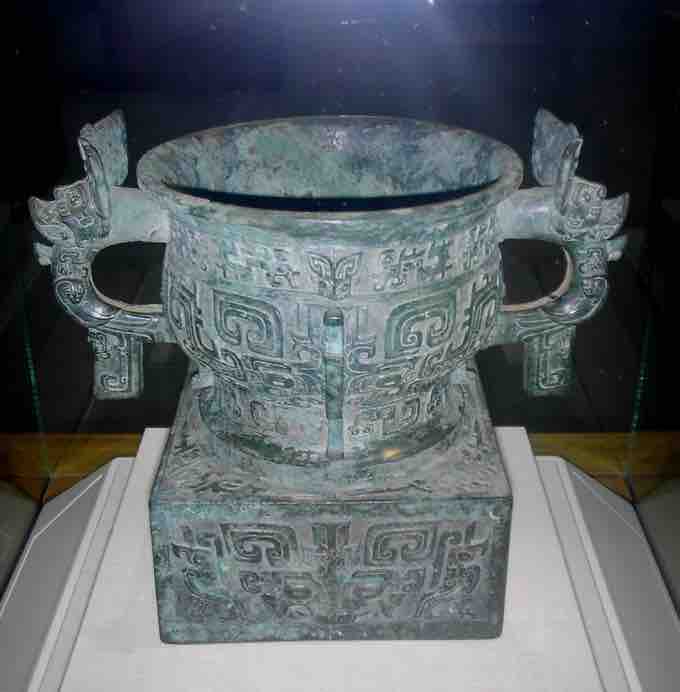Introduction: The Zhou Dynasty
The Zhou Dynasty (1046–256 BCE) was a Chinese dynasty that followed the Shang Dynasty and preceded the Qin Dynasty. Although the Zhou Dynasty lasted longer than any other dynasty in Chinese history, the actual political and military control of China by the Ji family lasted only until 771 BCE, a period known as the Western Zhou. Though iron was introduced to China during the Zhou Dynasty, this period of Chinese history produced what many consider the zenith of Chinese bronze-ware making.
Bronze Work in the Zhou Dynasty
Cultural Influences
The archaeological record suggests that the Zhou were cultural opportunists. They were quick to adopt the material culture of the Shang, perhaps as a way of establishing their legitimacy. Zhou art also borrowed heavily from the Shang, and the Zhou practice of casting inscriptions in bronze vessels, as well as the design of the vessels themselves, suggests a direct Shang influence.
Bronze Inscriptions
Many large bronzes bear cast inscriptions that are the great bulk of the surviving body of early Chinese writing and have helped historians and archaeologists piece together the history of China, especially during the Zhou Dynasty. The bronzes of the Western Zhou Dynasty document large portions of history not found in the existing texts of the time, and the medium of cast bronze lends the record a permanence not enjoyed by manuscripts. These inscriptions can commonly be subdivided into four parts: a reference to the date and place, the naming of the event commemorated, the list of gifts given to the artisan in exchange for the bronze, and a dedication. The relative points of reference these vessels provide have enabled historians to place most of the vessels within a certain time frame of the Western Zhou period, allowing them to trace the evolution of the vessels and the events they record.
Uses and Types of Bronze
The Chinese bronze artifacts are generally either utilitarian, such as spear points, and other tools or weapons, or ceremonial/ritual, such as more elaborate versions in precious materials of everyday vessels. The majority of surviving Chinese ancient bronze artifacts are ritual forms rather than their equivalents made for practical use, either as tools or weapons. Weapons such as daggers and axes had a sacrificial meaning, symbolizing the heavenly power of the ruler. The strong religious associations of bronze objects led to a development of a great number of vessel types and shapes, which became regarded as classic and totemic and were copied, often in other media such as Chinese porcelain, throughout subsequent periods of Chinese art.
Zhou Dynasty bronze sword
An Eastern-Zhou bronze sword excavated from Changsa, Hunan Province
Examples of ritual bronze vessels are the numerous large sacrificial tripods known as dings, along with many other distinct shapes such as gui and zun. Dings are prehistoric and ancient Chinese cauldrons, standing upon legs with a lid and two facing handles. They are one of the most important shapes used in Chinese ritual bronzes and were generally made in two shapes: round vessels with three legs and rectangular vessels with four, the latter often called fanding. They were often used for cooking, storage, and ritual offerings to the gods or to ancestors. Gui are a type of bowl-shaped ancient Chinese ritual bronze vessel used to hold offerings of food and for ancestral tombs. Zun are wine and sacrificial vessels characterized by a tall cylindrical shape with no handles or legs and a mouth that is usually slightly broader than the body. In the late Zhōu Dynasty, this type of vessel became exceedingly elaborate, often taking the shape of animals and abandoning the traditional shape.

Zhou Bronze
A Western Zhou bronze gui vessel, c. 1000 BC.
The ritual books of China during the Zhou Dynasty describe who was allowed to use what kinds of sacrificial vessels. The king of Zhou, for example, used 9 dings and 8 gui vessels; a duke was allowed to use 7 dings and 6 guis; a baron could use 5 dings and 3 guis; and a nobleman was allowed to use 3 dings and 2 guis. Surviving identified Chinese ritual bronzes from the Zhou Dynasty tend to be highly decorated, often with the taotie motif, which involves highly stylized animal faces. These appear in three main motif types: those of demons, symbolic animals, and abstract symbols.